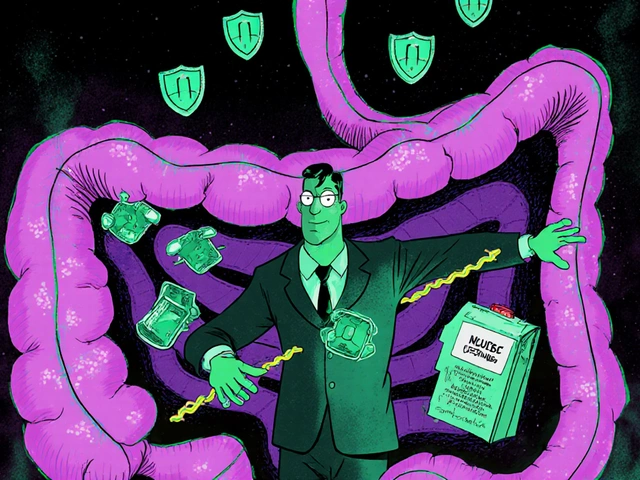Sick of the numbers on your cholesterol lab creeping up, even while popping atorvastatin every night? You’re not alone. Docs today see more folks who still can’t get those LDL levels down enough with one pill, even at max doses. But what if there was a way to drop your cholesterol lower—without doubling up your statin and bracing for muscle pain? Here’s a little secret: sometimes, two is better than one. The world of combination therapy is flipping the switch for cholesterol management. Let’s break down the new rules—and give you a playbook for getting real results.
Why Atorvastatin Alone Isn’t Always Enough
Atorvastatin still sits on top of prescriptions for cholesterol—after all, it works, and most insurance covers it. It’s often the first pick when your LDL is too high, partly because it blocks your liver from making so much bad cholesterol. But, for some people, maxing out on statins just doesn’t cut it. You might notice numbers barely budge, or side effects kick in before you reach target levels. Here’s something wild: about half the people at high risk for heart disease don’t hit their LDL goal with statins alone, even when they follow every order. That’s not a tiny group!
And the other downside? The higher the statin dose, the greater the risk for muscle pain, abnormal blood sugar, and brain fog. Constant aches or not being able to finish a walk can get old fast. So, why force a solo approach when the science now says ‘double up’ might actually be better—for results and for your day-to-day life?
That’s when doctors start talking about add-on therapies. These are treatments you take alongside your statin, aiming to drop your LDL further without cranking up side effects. The top two right now? Ezetimibe and the newer PCSK9 inhibitors. Instead of squeezing out every drop of a statin, combining can be smarter, safer, and get you where you want faster.
Ezetimibe: Small Pill, Big Impact
If you like simple, ezetimibe is hard to beat. It’s a single daily pill that works in a totally different way from statins: instead of blocking cholesterol production in the liver, it actually prevents cholesterol in your food from getting absorbed in the gut. At first glance, it might not sound dazzling. But here’s what happens when you add that little white tablet to your daily atorvastatin: average LDL drops by another 20-25%. That can be a game-changer if you’re just above your target, or if your family history makes your goal extra low.
Ezetimibe is also easy on side effects. You don’t get the notorious muscle aches, and it’s extremely safe with hardly a blip in other labs. For instance, a big study called IMPROVE-IT proved that adding ezetimibe to simvastatin helped people who had heart attacks drop their future risk more than statin alone—and the main discomfort reported was a little stomach upset or headache, not muscle pain.
Best part? Ezetimibe is generic, so you’re not shelling out big bucks. Docs usually start patients at 10 mg daily, tacked right on with your usual statin dose. If that gets your numbers where they need to be, you might be able to atorvastatin alternative options to keep side effects down and wallet happy. Curious about more choices? Check out a detailed list of next-level therapies here: atorvastatin alternative.

PCSK9 Inhibitors: High-Tech Tools for Big Drops
Maybe you’re in the boat where neither high-dose atorvastatin nor adding ezetimibe is enough. That’s where PCSK9 inhibitors come in. The science behind these sounds like something out of a spy novel. PCSK9 is a protein floating in your blood that basically acts like a bouncer for cholesterol receptors in your liver—the more you have, the less your body can clear LDL. PCSK9 inhibitors are drugs—given as an injection, usually every 2-4 weeks—that tell your body’s ‘bouncers’ to back off and let your cholesterol receptors do their job.
Results from the FOURIER and ODYSSEY OUTCOMES trials (real names!) showed LDL levels plummet by 50-60% above statin alone. That’s a massive improvement, especially for folks with a genetic predisposition, diabetes, or past heart events where every point counts. People who took PCSK9 inhibitors with their statin were far less likely to have heart attacks, strokes, or even die from heart disease. We’re not talking just about moving the numbers, but about bigger life outcomes.
The catch? These drugs aren’t pills—they’re shots you or a family member gives under the skin (kind of like an insulin pen). Also, they’re expensive, though many insurance companies now cover them if your risk is high or if nothing else brings your cholesterol down. Side effects are rare: a little redness at the injection site or mild cold symptoms. No muscle pain, no mental fog.
Who are PCSK9 inhibitors for? Think folks who have already had a heart attack, patients with inherited sky-high cholesterol, or even those with diabetes who need their LDL ultra-low. The effect is quick—within a month, labs usually show results that would take months or years with statins alone.
How Combination Therapy Changes Cholesterol Management
Twenty years ago, it was all about pushing statins as high as they’d go. Now, most national guidelines—including the American Heart Association and European Society of Cardiology—say combination therapy is the way to go when one med isn’t enough. Docs now start thinking about add-ons as soon as they see your numbers aren’t at goal, instead of just boosting your statin dose and hoping for the best.
This matters beyond the numbers. People who add ezetimibe or a PCSK9 inhibitor are less likely to stop therapy due to side effects. They’re also less likely to miss doses, since once-a-month injections or one extra pill doesn’t make a big dent in daily routine. For younger adults with genetic cholesterol issues, starting combo therapy early means a shot at living decades longer without a heart attack or stroke. For older adults, it means less time dealing with pain or brain fog, and more time feeling like themselves.
Insurance is also shifting. More plans recognize that preventing a heart attack costs a lot less than a hospital stay, so coverage for ezetimibe and PCSK9 inhibitors is easier to get than ever. Generic options and patient assistance programs help even if you’re paying out-of-pocket. If your doctor hasn’t talked about combo therapy when your LDL won’t budge, it’s ok—just bring it up. Most are eager to break out of the ‘statins only’ rut.

Tips for Taking Combination Therapy—And Getting Results
So how do you make the most of combo therapy for cholesterol? First, stick with it. The benefits add up over time—quitting early or missing doses won’t get you there. If you’re worried about costs, ask your pharmacist about generics and insurance pre-approval. Some manufacturers even offer discount cards or help if insurance balks.
Track your progress. Get your labs done as recommended, and keep a log of your numbers (even just in your phone’s notes). Seeing your LDL drop not only keeps you motivated, it gives your doctor real evidence to keep pushing for better coverage or dose tweaks. If you get side effects, bring them up early. Sometimes swapping brands, tweaking times, or splitting doses makes a difference.
Diet still counts, even with combo pills or shots. Meds and food work together better—oatmeal, olive oil, and more veggies help the drugs do their part. And if you ever need a break for surgery or other big changes, communicate with your healthcare team to avoid a rebound in cholesterol.
Big tip: Don’t settle for ‘just okay’ results or live in fear of the next lab report. There’s a new world of options out there—and combining therapies built for your unique risk can mean not just lower LDL, but a healthier, longer life.



Combination therapy is the smarter route for many patients, especially when atorvastatin alone fails to get LDL to goal.
Adding ezetimibe or a PCSK9 inhibitor changes the calculus because they act on completely different parts of cholesterol metabolism.
Ezetimibe blocks intestinal absorption and usually yields a reliable 20–25% additional LDL reduction when paired with a statin.
PCSK9 inhibitors, delivered by injection, unleash the liver's receptors and can cut LDL by half or more on top of statin therapy.
The clinical trials and guidelines cited are not just about numbers, they are about preventing hard outcomes like heart attacks and strokes.
FOURIER and ODYSSEY demonstrated that LDL reductions with PCSK9 inhibitors translate into fewer cardiovascular events over time.
IMPROVE-IT showed that even modest added reductions with ezetimibe improve outcomes after acute coronary syndrome.
For clinicians and patients, the practical takeaway is to tailor therapy to individual risk and tolerance rather than reflexively increasing statin dose.
Monitoring remains key: baseline liver enzymes and routine lipid panels guide therapy adjustments and verify adherence.
Most patients tolerate ezetimibe exceptionally well and can use it without the myalgias that sometimes follow high-dose statins.
PCSK9 inhibitors have a low side effect profile aside from injection-site reactions and are increasingly supported by payers for high-risk patients.
Cost and access can still be barriers, but patient assistance programs and prior authorization pathways often bridge that gap.
Lifestyle interventions are not obsolete when on combination therapy; diet, exercise, and weight management synergize with medications.
Clear, frequent communication with the healthcare team reduces interruptions in therapy and helps resolve side effects early.
Keeping a simple log of lab values and medication dates empowers patients and provides useful data during authorization appeals.
Overall, combination therapy is not a last resort anymore but a routine, evidence-based option for many people who need lower LDL targets.
Love that ezetimibe is cheap and chill on side effects - tiny pill, big payoff 💊👍
For a lot of folks, adding that beats cranking statin doses and dealing with aches that ruin daily life.
PCSK9 inhibitors are a revolution, plain and simple.
From a mechanistic standpoint, it is laughable to insist on monotherapy when the evidence base supports targeted combination approaches.
There is an obsession among some clinicians with dose escalation for its own sake, as if bigger pills equal better care.
Precision here means using different mechanisms to attack the same outcome, not smashing one pathway harder.
Any clinician who still reflexively maxes statins without serious consideration of add-ons is behind the curve.
We already have hard endpoints showing fewer cardiac events with combo strategies in the right populations, so the argument about anecdotal muscle pain should not block sensible risk reduction.
Insurance logistics are a pain but not an ethical excuse to withhold proven therapies.
On the muscle pain point, patients often benefit from a quick trial off the statin and then restarting at a different time of day, or switching the statin, before giving up entirely 🙌
Small changes like that keep people on lifesaving therapy and reduce unnecessary escalation.
Big pharma is always nudging new injections and bells, so it's hard not to be suspicious when injections are marketed like miracles.
There is a pattern where affordability and long-term access get swept under the rug while shiny new options get applause.
People need to watch out for being pushed into expensive regimens that could end up being unaffordable in a year.
Industry profit is real, but clinical guidelines and trial data still matter a lot for high-risk patients; when someone has familial hypercholesterolemia or prior MI, the math favours aggressive LDL lowering.
Patient assistance and step therapy exist to prevent people from being stranded because of sticker shock, and many centers will help with prior auth paperwork.
Practical checklist for folks trying combo therapy: get a baseline lipid panel, note dates of meds in your phone, ask your doc for expected LDL percent change, and request a prior auth early if you might need a PCSK9.
Also keep a simple food log for a month to show that meds and diet are being addressed together.
That checklist is gold, and keeping the log makes follow-ups so much smoother 😊
Philosophically speaking, the move toward combination therapy reflects a shift from heroic monotherapy to systems thinking, where multiple small interventions combine for a robust result.
It appeals to a more mature clinical epistemology that values risk reduction across domains rather than single-drug triumphalism.
When framed that way, paying attention to psychotherapy-like adherence techniques and structural access issues becomes part of the medical plan.
I switched to ezetimibe add-on last year and my LDL dropped like a rock - no aches, no drama, and saved me from upping the statin dose so thanks for the practical vibes 🙂
Great to hear that a real-world trial worked out and that side effects were avoided while achieving target numbers.
Real-world experiences like that are why clinicians are comfortable recommending add-ons earlier now that the evidence base supports them.
Staying on top of follow-up labs and communicating cost concerns up front really changes outcomes for patients.
Clinical pragmatism plus rigorous evidence is the combination that wins every time; rhetoric without data is just noise.
Use the right mechanism for the right indication, get the paperwork done, and stop worshipping higher doses as the only virtue.
Ezetimibe plus a statin is often the sweetest spot for folks who hate side effects but need better LDL control.
It blocks gut absorption, so you get a complementary mechanism without throwing more stress at your muscles or liver. For people creeping above target, that 20–25% extra drop can be the difference between being labeled high risk and being stable. Stick to the plan, check labs on schedule, and your doc can fine tune whether you keep the combo or step up to a PCSK9 later on.
Also worth saying: if cost is a barrier, generic ezetimibe is a real win versus jumping straight to expensive injectables. Use patient assistance and preauthorization when needed, and don’t let sticker shock force unnecessary dose escalations.
Big pharma has an interest in making monotherapy look inadequate so people chase newer, pricier options.
PCSK9 drugs do work, sure, but the push to replace old standbys with high-cost injectables reads like a sales play at times. Insurance gatekeeping and prior auths are the only things keeping costs semi-reasonable for now. For people without genetic hypercholesterolemia, maximizing lifestyle and ezetimibe first makes fiscal sense and keeps the system honest.
FOURIER and ODYSSEY are the studies everyone waves around as gospel nevertheless context matters
Those trial populations were high risk and already statin-treated so extrapolating wholesale to the average clinic patient is sloppy
PCSK9s cut LDL dramatically and reduce events in selected cohorts and that is undeniable
But blanket elevation of these agents into first-line thinking without rigorous cost-benefit for low-risk strata is intellectually lazy
There is nuance in endpoints, absolute risk reduction, and number needed to treat that most summaries omit
Clinical decision making should be individualized with math, not slogans
Combining drugs thoughtfully can really change quality of life for patients who hate side effects
Lowering the statin dose and adding ezetimibe often reduces muscle complaints and keeps adherence higher
That adherence is the silent hero here because medication only works when people take it consistently
We should make conversations about combination therapy routine rather than exceptional
Combination therapy has moved from niche to mainstream for good reasons.
First, the pharmacology is complementary: statins reduce hepatic cholesterol synthesis while ezetimibe reduces intestinal absorption, and PCSK9 inhibitors upregulate LDL receptor recycling. Putting these mechanisms together can create a synergistic effect that the single-agent approach often cannot match. From a practical standpoint, the real-world benefit is not merely the percent drop in LDL but the downstream reduction in cardiovascular events, hospitalizations, and long-term morbidity. The trials mentioned in the post-IMPROVE-IT, FOURIER, ODYSSEY-provide high-quality evidence that supports adding therapies when statin monotherapy fails to reach target levels in higher-risk populations. Those studies also show safety profiles that should reassure clinicians who worry about introducing another agent into a regimen.
Second, patient experience matters a lot. Escalating statin dose to chase marginal LDL improvements frequently provokes muscle symptoms, fatigue, and discontinuation. Adding ezetimibe usually avoids those issues and can stabilize adherence. For patients who still need more lowering, PCSK9 inhibitors offer substantial reductions without the typical statin-related muscle complaints. The delivery mode is different-subcutaneous injections-but many patients find monthly or biweekly dosing tolerable, especially when it prevents recurrent cardiac events.
Third, economics are changing. Generic ezetimibe provides a cost-effective step up for most patients, and evolving payer policies have made PCSK9 agents more accessible for patients with documented high risk or familial hypercholesterolemia. Assistance programs and manufacturer copay options reduce out-of-pocket burden in many cases, which alters the calculus clinicians have to perform at the point of care. Importantly, the cost of preventing even a single myocardial infarction or stroke dwarfs the medication cost when you consider hospitalization, procedures, rehabilitation, and lost productivity.
Fourth, treatment plans should be individualized and dynamic. Baseline risk, comorbidities, patient preferences, and prior tolerance to therapy all factor into whether ezetimibe, a PCSK9 inhibitor, or another agent like bempedoic acid is the most appropriate add-on. Lifestyle modifications remain foundational and potent when combined with medication. Diet, exercise, weight management, and smoking cessation amplify pharmacologic effects and reduce overall cardiovascular risk.
Finally, clinicians should communicate goals clearly and track outcomes. Regular lipid panels, documentation of side effects, and transparent conversations about trade-offs empower patients to commit to regimens that improve both numbers and quality of life. The bottom line is simple: combining therapies thoughtfully can achieve LDL goals faster and more safely than simply cranking up statin doses, and that matters for both short-term tolerability and long-term event reduction.
Nice concise breakdown, I agree with the combo-first mindset.
There is a moral dimension to medicine here that cannot be ignored.
Choosing a treatment is not merely an exercise in lowering lab values but an act that touches the arc of a life. When a clinician opts for combination therapy to preserve a patient's daily functioning while also reducing long-term risk, that is a choice grounded in respect for human flourishing. Conversely, when cost, inertia, or simplistic protocol dictate care, patients pay the price in lost opportunities and avoidable suffering.
Philosophically, the move toward combinations reflects an ethic of prudence. Rather than pushing one intervention to its painful limits, we combine lower-intensity acts that together produce a superior result. It is an approach that honors complexity and refuses false binaries.
Pharma spin aside, the data and patient outcomes speak loud enough to not waste time on theatrics.
We need fewer headlines and more treatment plans that actually keep people out of the ER and alive to enjoy their grandkids.
Guidelines now explicitly recommend combination strategies for many clinical phenotypes and that is reflected in contemporary practice.
From a pharmacokinetic standpoint, the interactions are minimal between statins and ezetimibe because they act on distinct pathways. Bempedoic acid provides another oral option by inhibiting ATP-citrate lyase upstream of HMG-CoA reductase, and it can be useful for statin-intolerant patients though the LDL reduction is more modest. PCSK9 monoclonal antibodies bind circulating PCSK9 and prevent receptor degradation, resulting in marked upregulation of LDL receptor-mediated clearance. Inclisiran, an siRNA therapeutic, offers an alternative mechanism by durably suppressing hepatic PCSK9 synthesis with infrequent dosing intervals, which may improve adherence and lower system costs over time.
Clinicians should stratify patients using absolute risk calculators, account for familial hypercholesterolemia through cascade screening, and select agents based on mechanism of action, tolerability, and access. In the global context, awareness of formularies and biosimilar development is crucial for scaling advanced therapies sustainably.
Real-world adherence and equity must drive how we implement these options.
When combinations reduce side effects and simplify regimens, more patients stay on therapy and reap benefits. That decreases disparities in outcomes over time. Policies that expand access to proven add-ons like ezetimibe and PCSK9 inhibitors for those at highest risk are ethically justified because prevention is both humane and cost-effective.
Thanks all for practical takes, a few quick closing thoughts.
Start low, go combo before maxing out, use generics when possible, and document side effects so insurance appeals can be supported. Lifestyle still matters and works synergistically with these meds, so keep that part of follow-up. For patients who can’t tolerate statins at all, newer agents give real options that weren’t around a decade ago. Finally, keep communication open with your provider and pharmacist to navigate costs and dosing. Small, steady wins in LDL reduction add up to major wins for long-term heart health.